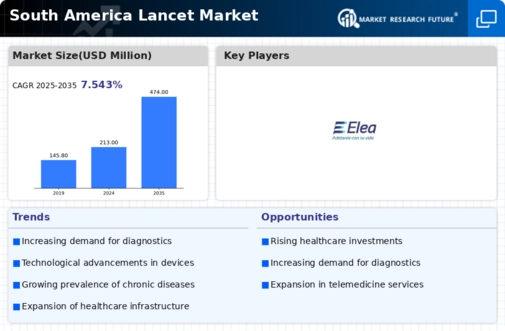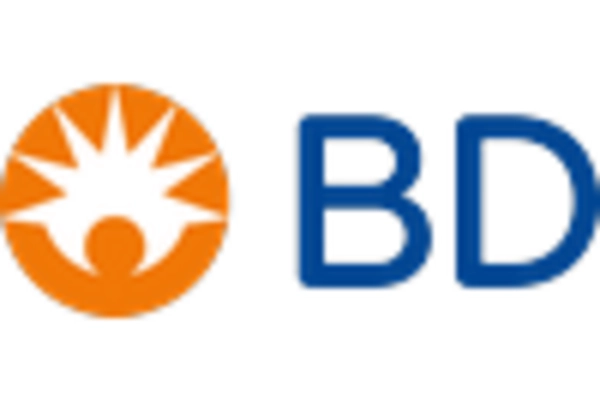Increasing Healthcare Expenditure
The rising healthcare expenditure in South America is a pivotal driver for the lancet market. Governments and private sectors are allocating more funds towards healthcare infrastructure, which includes the procurement of medical supplies such as lancets. In 2025, healthcare spending in the region is projected to reach approximately $500 billion, reflecting a growth rate of around 5% annually. This increase in investment is likely to enhance the availability of medical devices, thereby boosting the demand for lancets. Furthermore, as healthcare systems evolve, there is a growing emphasis on improving patient outcomes, which necessitates the use of high-quality medical supplies. Consequently, the lancet market stands to benefit from this trend as healthcare providers seek reliable and efficient tools for blood sampling.
Rising Awareness of Diabetes Management
The growing awareness surrounding diabetes management in South America significantly influences the lancet market. With diabetes prevalence increasing, educational campaigns and health initiatives are being implemented to promote regular monitoring of blood glucose levels. In 2025, it is estimated that approximately 10% of the adult population in South America will be diagnosed with diabetes, necessitating the use of lancets for blood sampling. This heightened awareness is likely to drive demand for lancets, as patients require reliable tools for self-monitoring. Additionally, healthcare providers are increasingly recommending regular blood tests, further propelling the lancet market. As a result, the focus on diabetes management is expected to create substantial growth opportunities for lancet manufacturers and suppliers in the region.
Technological Integration in Healthcare
The integration of technology in healthcare practices in South America is emerging as a significant driver for the lancet market. Innovations such as smart lancets and connected devices are gaining traction, enabling patients to monitor their health more effectively. In 2025, the market for smart medical devices is expected to grow by approximately 15%, indicating a shift towards more advanced healthcare solutions. This technological evolution is likely to enhance the user experience and improve the accuracy of blood sampling. As healthcare providers adopt these technologies, the demand for advanced lancets is expected to rise, thereby positively impacting the lancet market. The convergence of technology and healthcare is poised to create new opportunities for manufacturers and suppliers in the region.
Expansion of Retail Distribution Channels
The expansion of retail distribution channels in South America is a crucial driver for the lancet market. As healthcare products become more accessible, the availability of lancets in pharmacies, supermarkets, and online platforms is increasing. This trend is particularly relevant in urban areas, where consumers are seeking convenience in purchasing medical supplies. In 2025, it is projected that online sales of healthcare products will account for approximately 20% of total sales in the region. This shift towards e-commerce is likely to enhance the visibility of lancets, making them more readily available to consumers. Consequently, the lancet market is expected to experience growth as retailers expand their offerings and consumers gain easier access to essential medical supplies.
Government Initiatives for Health Improvement
Government initiatives aimed at improving public health in South America are significantly impacting the lancet market. Various health programs are being launched to address chronic diseases, including diabetes and cardiovascular conditions, which require regular blood testing. In 2025, it is anticipated that government spending on health initiatives will increase by 7%, focusing on preventive care and early diagnosis. These initiatives often include the distribution of medical supplies, such as lancets, to ensure that patients have the necessary tools for monitoring their health. As a result, the lancet market is likely to benefit from increased demand driven by these government-led health programs, which aim to enhance overall health outcomes in the population.



















Leave a Comment